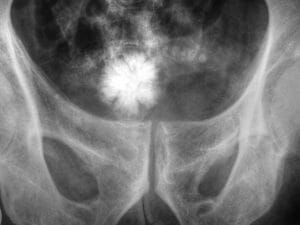Urinary Bladder Definition
The urinary bladder is an organ present in the urinary tracts of several animal species. Prior to urination, it stores urine produced and delivered by the kidneys through two ureters. The human urinary bladder is hollow, muscular, and can hold up to four cups of urine.
Urinary Bladder Overview
The structural composition of the bladder includes a broad fundus, body, apex, and neck. The human bladder contains three openings, each covered by a mucosal flab that prevents urine from flowing backward into the ureters. The anatomical position of the bladder differs between men and women.
In men, the urinary bladder is located in front of the rectum, whereas, in women, it is positioned in front of the uterus. The bladder wall is extremely elastic, stretching from approximately 5 mm to less than 3 mm due to folds called rugae, which cover the inner walls. Please see the diagram of the urinary bladder below:
The bladder can hold a considerable amount of urine, which allows the kidneys the ability to continue filtering the blood even when an organism cannot urine. For example, during sleep, the bladder must store extra urine. This allows an organism to rest without needing to urinate.
Urinary Bladder Function
The function of the urinary bladder is to collect and store urine from the kidneys until it can be excreted via urination. The typical human bladder can store an average of 300 mL to 500 mL of urine. As described above, the urinary bladder is highly elastic and is able to accommodate an increased volume of liquid due to the flattening of the rugae folds. Urination is not controlled by the bladder, but rather the pontine micturition center in the brain.
Diseases of the Urinary Bladder
There are several diseases of the urinary bladder. The typical symptoms of bladder diseases include frequent urination, pain, incomplete emptying, and irritation. Occasionally, diseases of other tissues or organs can affect the urinary bladder. For example, an enlarged prostate can cause frequent urination. The following are some of the most common pathologies of the urinary bladder:
Bladder Cancer
The most common type of bladder cancer occurs in the epithelial lining of the bladder. In fact, approximately 90% of all bladder cancer are carcinomas. The use of certain medications, cigarette smoke exposure, and infections are considered the most common causes of bladder cancer.
Urinary Tract Infection
Urinary tract infections (UTIs) are a common occurrence that can be severe and pose a major public health concern. These infections are caused by bacterial infections in the bladder, usually caused by bacteria traveling up the urethra and into the bladder. When left untreated, UTIs can be very dangerous, as the infection can progress from the bladder into the kidneys. Common symptoms include a burning sensation during urination, cloudy and/or foul-smelling urine, and the frequent urge to urinate, despite little urine being released.
Bladder Stones
Bladder stones are hard deposits composed of minerals found in the bladder caused by dehydration and highly concentrated urine residing in the bladder. Stones can vary in size and are typically asymptomatic. Common symptoms are typically pain, blood in the urine, and irritation. X-rays (shown below), ultrasound, and CT scans are typically used to identify bladder stones.

Neurogenic Bladder
Neurogenic bladder is a type of brain disorder that impacts an individual’s ability to urinate. Since the peripheral nerves involved in urination are affected, urination is typically aided with a catheter. Patients often need to use intermittent catheterization several times a day to empty their bladder.
Bladder Exstrophy
Bladder exstrophy is a congenital abnormality which involves the protrusion of the bladder through the wall of the abdomen. This condition is extremely rare and is often accompanied by the abnormal development of the pelvic floor and other muscles, as well as the genitals, especially in women.
Bladder Sphincter Dyssynergia
Bladder sphincter dyssynergia refers to a condition in which the urethral sphincter cannot be relaxed in coordination with bladder contraction. This condition is typically caused by a central nervous system injury or disorder. Patients frequently experience urine retention and a history of bladder infections.
Paruresis
Paruresis refers to a phobia involving the inability to urinate due to the presence or perceived presence of others. This disorder is caused by a sympathetic nervous system response which tightens the sphincters in the bladder in response to adrenaline, thereby preventing urination. Typically, treating this condition requires psychological therapy.
Trigonitis
Trigonitis is a condition involving inflammation of the trigone region of the bladder. In particular, the trigone is a smooth triangular-shaped region and signals the need for urination in response to stretching. An inflammation of this region can result in an urgent need to urinate, pain in the pelvic region, and pain or difficulty urinating. Although there are several causes of trigonitis, bladder infections are the most common etiology.
Interstitial Cystitis
Interstitial cystitis is a condition characterized by chronic bladder pain. While the specific cause of interstitial cystitis is unknown, patients exhibit damage to the epithelial lining of the bladder. Patients often experience the urge to urinate, frequent urination, and pain. Since the symptoms are highly similar to that of a urinary tract infection, a negative urine culture is typically used to establish a diagnosis.
Urinary Retention
Urinary retention is a condition in which an individual is unable to completely empty the bladder. Symptoms include poor pressure when urinating, the sensation of a full bladder, and straining to urinate. This condition is considered to be an emergency since the bladder could rupture if left untreated. Although there are a variety of causes, treatment often involves catheterization and in some cases, surgery may be required.
Quiz

